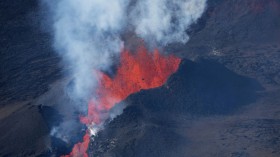Researchers from the National Oceanic and Atmospheric Administration (NOAA) and Bishop Museum discovered a new species of butterflyfish genus Prognathodes in the deep reefs of the Papahānaumokuākea Marine National Monument.
The new species, described in a paper published in the journal Zoology, was in the poorly explored mesophotic coral ecosystems, or "the coral reef twilight zone", at the depths of 150 to 500 feet. Coral reefs and marine life living in these zones represents a new frontier research. It is deeper than most scuba divers could venture and shallower than most submersible-based exploration.
Named after local veteran diver Pete Basabe, the new butterflyfish, called Prognathodes basabei, was first observed 20 years ago in a video take by manned submersibles at the depths as great as 600 feet. Due to its extreme depths, it is only possible to collect and preserve specimens of the butterflyfish using advanced electronic closed-circuit rebreathers available at the present time.
"Butterflyfish are the glamour fish of the coral reefs," said Richard Pyle, Bishop Museum scientist and lead author of the paper, in a statement. "They are colorful, beautiful, and have been very well-studied worldwide. Finding a new species of butterflyfish is a rare event."
NOAA was able to draw descriptions of the new butterflyfish from the data they have gathered during regular encounter of the fish in their deep exploratory dives in Papahānaumokuākea. Additionally, live specimens of the new butterflyfish were also collected during the NOAA expedition last June. These samples are now on display Bishop Museum in Honolulu, Deep Reef exhibit at the Waikiki Aquarium and Mokupāpapa Discovery Center in Hilo.
Prognathodes basabei has a small mouth with slightly protruding upper jaw. It has a color in life pale yellow dorsally fading to white ventrally (sometimes entirely white) with three black bands with narrow white margins on each side of the body.
The new butterflyfish has been observed and collected at the depths of 147 to 600 feet at several locations throughout the Hawaiian Archipelago, including both the main Hawaiian Islands and Northwestern Hawaiian Islands.
© 2024 NatureWorldNews.com All rights reserved. Do not reproduce without permission.





